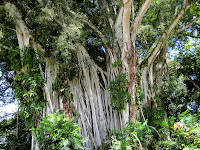 Let’s talk about a special place on the island of Oahu that you can feel close to the mana (spiritual power) of the gods, chiefs and people of ancient Hawaii. Ulupō Heiau is the second largest heiau on the island of Oahu (the largest is Pu'u o Mahuka Heiau overlooking Waimea Valley on the North Shore) and is said to have been built by the menehune (little people) in the 1400s. “Ulupō” means “Night Inspiration” in the Hawaiian language and is said to
Let’s talk about a special place on the island of Oahu that you can feel close to the mana (spiritual power) of the gods, chiefs and people of ancient Hawaii. Ulupō Heiau is the second largest heiau on the island of Oahu (the largest is Pu'u o Mahuka Heiau overlooking Waimea Valley on the North Shore) and is said to have been built by the menehune (little people) in the 1400s. “Ulupō” means “Night Inspiration” in the Hawaiian language and is said tobe a special place where energy is captured from the stars. This sacred temple is located in Kailua. The function of Ulupō Heiau changed over time. It probably began as an agricultural heiau or heiau mapele (temple for ceremonies to insure fertility of the crops). But over time, according to history and its shape, it was made into a heiau luakini (temple dedicated to the success of war). If so, then the heiau luakini was considered a restricted area that was only for those of high hierarchy. Today, this heiau is a sacred site for all Hawaiian people.

Ulupō Heiau is listed on the National and Hawai'i Registers of Historic Places. The State Parks continue to preserve the heiau and heighten public awareness of the cultural history of Kawai Nui. History indicates that Kawai Nui Marsh and Ka'elepulu Pond were ocean bays and that the first Polynesians came to the shores of Kawai Nui Lagoon and built heiau, fishponds and taro terraces.

 View of Kawai Nui Marsh
View of Kawai Nui MarshTop of heiau
Kailua was the place of political power for the district of Ko'olaupoko in the 1750’s. The ali'i of O'ahu favored this area for its abundance of fish and good canoe landings. As notes taken from our ancient text show, the houses of the ali'i (chiefs), their families and their attendants surrounded Kailua Bay. Behind the sand beach was the large, fertile expanse of Kawai Nui which had been converted to a fishpond surrounded by an agricultural field system. Kawai Nui was a large, 400 acre fishpond with an abundance of mullet, awa, and o'opu. Ka'elepulu and Nu'upia fishponds were nearby.
Farmers grew kalo (taro) in the irrigated lo'i along the fishponds. Dryland kalo, banana, sweet potato and sugarcane were grown around the marsh area. The fishermen harvested fish from the fishponds and the ocean. The kahuna (priests) performed their religious rites around Kawai Nui at Ulupō Heiau on the east and the Pahukini Heiau and Holomakani Heiau on the west.
Ulupō Heiau measures 140 by 80 feet with walls up to 30 feet in height. The legendary association of the heiau with menehune suggests the antiquity of this site. The construction of this massive temple required a large work force as well as a large amount of rocks. It has been noted that one source of these stones was Kualoa, more than ten miles away.
Several O'ahu chiefs lived at Kailua and probably participated in ceremonies at Ulupō Heiau. Maui chief Kahekili came to O'ahu in the 1780s and lived in Kailua after defeating O'ahu high chief Kahahana for control of the island. Kamehameha I worked at Kawai Nui Fishpond and is said to have eaten the edible mud (lepo ai ia) of Kawai Nui when there was a shortage of kalo. But by 1795 when Kamehameha I conquered O'ahu, it is believed that Ulupō Heiau was already abandoned.
The Chinese planted rice around the edge of Kawai Nui Marsh in the 1800s. The kalo fields were converted to rice fields. A cattle pen was said to have been built on top of the heiau in the 1920s. The cattle changed the shape of the heiau due to heavy usage. The last people to have used the heiau are the Japanese. There is evidence of their pig pens and homes dating from 1949 to 1974, not too long ago.
You will feel a wonderful sense of energy when you visit Ulupō Heiau. There is a beautiful view of the mountains and the Kawai Nui Marsh. Many trees grow there, kukui, noni, macadamia, hala, palm, ulu (breadfruit) and banana to name a few. Taro and ti leaf are also grown. The marsh is a habitat for Hawaii’s endangered waterbirds. I ask that you be respectful of this sacred area. Stay on the trails for the rocks may be loose. Please also be respectful of the offerings that are left there. Ulupō Heiau…definitely a place that you must visit to understand the value of the Native Hawaiian culture.

 Ape, related to kalo
Ape, related to kaloMacadamia Nut

 Ti leaf, heiau in background
Ti leaf, heiau in backgroundKukui Nut

 Sugar cane
Sugar caneUlu, Breadfruit

 Hala
HalaGinger

 Banana
BananaKalo (taro)

 Banyan
BanyanPalm


Hula Mound
Terraces, remnants of home
Honolulu Festival







No comments:
Post a Comment